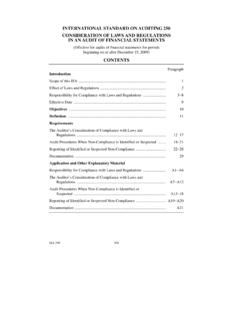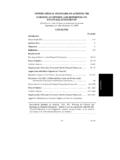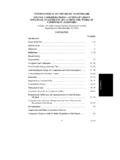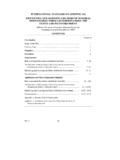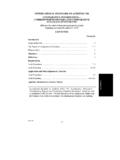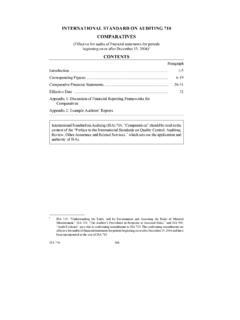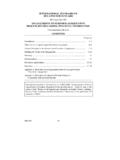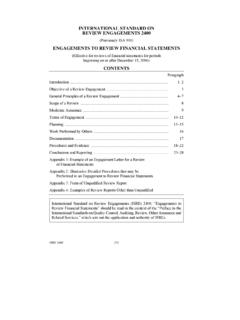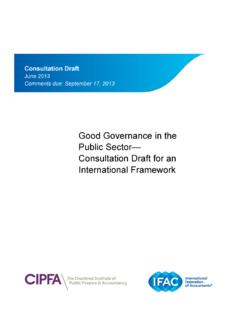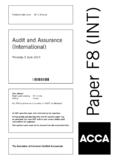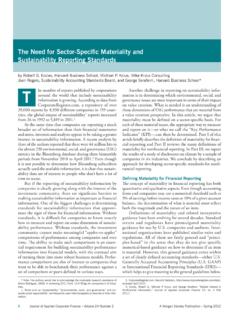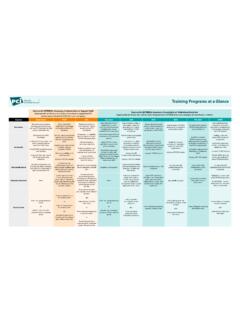Transcription of INTERNATIONAL STANDARD ON AUDITING 300 …
1 ISA 300 249 AUDITING INTERNATIONAL STANDARD ON AUDITING 300 PLANNING an audit of financial statements (Effective for audits of financial statements for periods beginning on or after December 15, 2009) CONTENTS Paragraph Introduction Scope of this ISA .. 1 The Role and Timing of Planning .. 2 Effective Date .. 3 Objective .. 4 Requirements Involvement of Key Engagement Team Members .. 5 Preliminary Engagement Activities .. 6 Planning Activities .. 7 11 Documentation .. 12 Additional Considerations in Initial audit Engagements .. 13 Application and Other Explanatory Material The Role and Timing of Planning .. A1 A3 Involvement of Key Engagement Team Members .. A4 Preliminary Engagement Activities .. A5 A7 Planning Activities .. A8 A15 Documentation .. A16 A19 Additional Considerations in Initial audit Engagements .. A20 Appendix: Considerations in Establishing the Overall audit Strategy INTERNATIONAL STANDARD on AUDITING (ISA) 300, Planning an audit of financial statements should be read in conjunction with ISA 200, Overall Objectives of the Independent Auditor and the Conduct of an audit in Accordance with INTERNATIONAL standards on AUDITING .
2 PLANNING an audit of financial statements ISA 300 250 Introduction Scope of this ISA 1. This INTERNATIONAL STANDARD on AUDITING (ISA) deals with the auditor s responsibility to plan an audit of financial statements . This ISA is written in the context of recurring audits. Additional considerations in an initial audit engagement are separately identified. The Role and Timing of Planning 2. Planning an audit involves establishing the overall audit strategy for the engagement and developing an audit plan. Adequate planning benefits the audit of financial statements in several ways, including the following: (Ref: Para. A1 A3) Helping the auditor to devote appropriate attention to important areas of the audit . Helping the auditor identify and resolve potential problems on a timely basis. Helping the auditor properly organize and manage the audit engagement so that it is performed in an effective and efficient manner.
3 Assisting in the selection of engagement team members with appropriate levels of capabilities and competence to respond to anticipated risks, and the proper assignment of work to them. Facilitating the direction and supervision of engagement team members and the review of their work. Assisting, where applicable, in coordination of work done by auditors of components and experts. Effective Date 3. This ISA is effective for audits of financial statements for periods beginning on or after December 15, 2009. Objective 4. The objective of the auditor is to plan the audit so that it will be performed in an effective manner. Requirements Involvement of Key Engagement Team Members 5. The engagement partner and other key members of the engagement team shall be involved in planning the audit , including planning and participating in the discussion among engagement team members. (Ref: Para. A4) PLANNING an audit of financial statements ISA 300 251 AUDITING Preliminary Engagement Activities 6.
4 The auditor shall undertake the following activities at the beginning of the current audit engagement: (a) Performing procedures required by ISA 220 regarding the continuance of the client relationship and the specific audit engagement;1 (b) Evaluating compliance with relevant ethical requirements, including independence, in accordance with ISA 220;2 and (c) Establishing an understanding of the terms of the engagement, as required by ISA (Ref: Para. A5 A7) Planning Activities 7. The auditor shall establish an overall audit strategy that sets the scope, timing and direction of the audit , and that guides the development of the audit plan. 8. In establishing the overall audit strategy, the auditor shall: (a) Identify the characteristics of the engagement that define its scope; (b) Ascertain the reporting objectives of the engagement to plan the timing of the audit and the nature of the communications required; (c) Consider the factors that, in the auditor s professional judgment, are significant in directing the engagement team s efforts; (d) Consider the results of preliminary engagement activities and, where applicable, whether knowledge gained on other engagements performed by the engagement partner for the entity is relevant; and (e) Ascertain the nature, timing and extent of resources necessary to perform the engagement.
5 (Ref: Para. A8 A11) 9. The auditor shall develop an audit plan that shall include a description of: (a) The nature, timing and extent of planned risk assessment procedures, as determined under ISA (b) The nature, timing and extent of planned further audit procedures at the assertion level, as determined under ISA 1 ISA 220, Quality Control for an audit of financial statements , paragraphs 12 13. 2 ISA 220, paragraphs 9 11. 3 ISA 210, Agreeing the Terms of audit Engagements, paragraphs 9 13. 4 ISA 315, Identifying and Assessing the Risks of Material Misstatement through Understanding the Entity and Its Environment. 5 ISA 330, The Auditor s Responses to Assessed Risks. PLANNING an audit of financial statements ISA 300 252(c) Other planned audit procedures that are required to be carried out so that the engagement complies with ISAs. (Ref: Para.)
6 A12) 10. The auditor shall update and change the overall audit strategy and the audit plan as necessary during the course of the audit . (Ref: Para. A13) 11. The auditor shall plan the nature, timing and extent of direction and supervision of engagement team members and the review of their work. (Ref: Para. A14 A15) Documentation 12. The auditor shall include in the audit documentation:6 (a) The overall audit strategy; (b) The audit plan; and (c) Any significant changes made during the audit engagement to the overall audit strategy or the audit plan, and the reasons for such changes. (Ref: Para. A16 A19) Additional Considerations in Initial audit Engagements 13. The auditor shall undertake the following activities prior to starting an initial audit : (a) Performing procedures required by ISA 220 regarding the acceptance of the client relationship and the specific audit engagement;7 and (b) Communicating with the predecessor auditor, where there has been a change of auditors, in compliance with relevant ethical requirements.
7 (Ref: Para. A20) ** Application and Other Explanatory Material The Role and Timing of Planning (Ref: Para. 2) A1. The nature and extent of planning activities will vary according to the size and complexity of the entity, the key engagement team members previous experience with the entity, and changes in circumstances that occur during the audit engagement. A2. Planning is not a discrete phase of an audit , but rather a continual and iterative process that often begins shortly after (or in connection with) the completion of 6 ISA 230, audit Documentation, paragraphs 8 11, and A6. 7 ISA 220, paragraphs 12 13. PLANNING an audit of financial statements ISA 300 253 AUDITING the previous audit and continues until the completion of the current audit engagement. Planning, however, includes consideration of the timing of certain activities and audit procedures that need to be completed prior to the performance of further audit procedures.
8 For example, planning includes the need to consider, prior to the auditor s identification and assessment of the risks of material misstatement, such matters as: The analytical procedures to be applied as risk assessment procedures. Obtaining a general understanding of the legal and regulatory framework applicable to the entity and how the entity is complying with that framework. The determination of materiality. The involvement of experts. The performance of other risk assessment procedures. A3. The auditor may decide to discuss elements of planning with the entity s management to facilitate the conduct and management of the audit engagement (for example, to coordinate some of the planned audit procedures with the work of the entity s personnel). Although these discussions often occur, the overall audit strategy and the audit plan remain the auditor s responsibility.
9 When discussing matters included in the overall audit strategy or audit plan, care is required in order not to compromise the effectiveness of the audit . For example, discussing the nature and timing of detailed audit procedures with management may compromise the effectiveness of the audit by making the audit procedures too predictable. Involvement of Key Engagement Team Members (Ref: Para. 5) A4. The involvement of the engagement partner and other key members of the engagement team in planning the audit draws on their experience and insight, thereby enhancing the effectiveness and efficiency of the planning Preliminary Engagement Activities (Ref: Para. 6) A5. Performing the preliminary engagement activities specified in paragraph 6 at the beginning of the current audit engagement assists the auditor in identifying and evaluating events or circumstances that may adversely affect the auditor s ability to plan and perform the audit engagement.
10 8 ISA 315, paragraph 10, establishes requirements and provides guidance on the engagement team s discussion of the susceptibility of the entity to material misstatements of the financial statements. ISA 240, The Auditor s Responsibilities Relating to Fraud in an audit of financial statements , paragraph 15, provides guidance on the emphasis given during this discussion to the susceptibility of the entity s financial statements to material misstatement due to fraud. PLANNING an audit of financial statements ISA 300 254A6. Performing these preliminary engagement activities enables the auditor to plan an audit engagement for which, for example: The auditor maintains the necessary independence and ability to perform the engagement. There are no issues with management integrity that may affect the auditor s willingness to continue the engagement.
